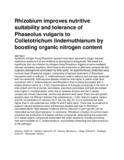Rhizobium improves nutritive suitability and tolerance of Phaseolus vulgaris to Colletotrichum lindemuthianum by boosting organic nitrogen content
Date
202-05Author
Karoney, Edwin, M
Ochieno, Dennis. M.W
Baraza, Danstone. L
Muge, Edward. K
Nyaboga, Evans. N
Naluyange, Victoria
Metadata
Show full item recordAbstract
Symbiotic nitrogen fixing Rhizobium species have been reported to trigger induced resistance reactions that are inhibitive to aboveground antagonists. We tested the hypothesis that root infection by nitrogen-fixing Rhizobium triggers enzyme-mediated induced resistance reactions, which lead to the production of defensive compounds that suppress aboveground colonization by foliar pests. An experiment was conducted using common bean Phaseolus vulgaris, comprising of factorial treatments of Rhizobium inoculation (with or without), C. lindemuthianum (with or without) and soil type (solarized and non-solarized). Anthracnose disease incidence was higher in plants under dual inoculation with C. lindemuthianum and Rhizobium than in plants inoculated with C. lindemuthianum alone (p < 0.05). Concentrations of N-based compounds in the form of total protein and the enzymes, peroxidase, ascorbate peroxidase and lipid peroxidase were higher in rhizobial plants, while that of catalase enzyme and the C-based compounds namely flavonoids, tannins and phenols were lower. Plant size and growth duration were not different between the treatments (p > 0.05). Soil pH, organic carbon and the concentration of nutrients (N, P, Na, Ca, Mg, Zn, Cu) in solarized soil were higher than in non-solarized soil, while Fe and K were lower. There was no evidence to support induced resistance since anthracnose disease was high in Rhizobium inoculated plants. High disease incidence without reduction in plant growth can be interpreted as host plant tolerance. In conclusion, Rhizobium infection of common bean enhances the production of N-based nutritive compounds, while limiting the production of C-based organic compounds associated with plant resistance, thereby promoting host plant suitability to C. lindemuthianum, and possibly enhancing host plant tolerance to the pathogen.
Collections
- Gold Collection [1026]

